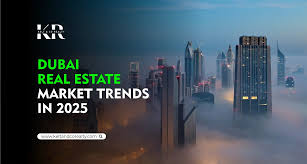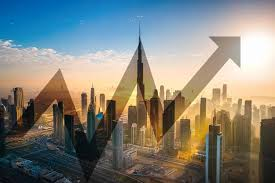

Dubai’s real estate market is thriving, cementing its position as a global hub for property investment. In 2024, the city recorded a staggering 226,000 real estate transactions valued at AED 761 billion (approximately USD 207 billion), reflecting a 36% increase in transaction volume and a 20% rise in value compared to 2023. The first quarter of 2025 alone saw 45,474 transactions worth AED 142.7 billion, signaling strong momentum. With a projected CAGR of 8.5% through 2030, Dubai’s real estate market offers significant opportunities for U.S. investors seeking high returns and diversification. This article explores the key trends driving this growth and the opportunities for investors, particularly from the United States.

Property prices in Dubai are expected to rise by 5-8% in 2025, with luxury segments in areas like Palm Jumeirah and Downtown Dubai potentially seeing increases of up to 10%. Rental yields remain a standout feature, averaging 7%, significantly higher than in U.S. cities like New York (4.2%) or Miami (5.1%). Short-term rentals, fueled by Dubai’s booming tourism sector, are projected to grow by 18%, while long-term rentals are expected to increase by 13%, driven by a growing expatriate population. For U.S. investors, these high yields offer a compelling alternative to domestic markets. highlights that Dubai’s rental market remains one of the most attractive globally.
Off-plan properties continue to dominate, accounting for 56% of transactions in Q1 2025. These projects, offered by developers like Emaar and DAMAC, attract investors with flexible payment plans and high appreciation potential. Emerging areas such as Dubai South, Emaar South, and The Valley are particularly popular due to their proximity to infrastructure projects like Al Maktoum International Airport. One-bedroom apartments, making up 68% of transactions in 2024, are a favorite for their affordability and strong rental demand. U.S. investors can benefit from entering these projects early, securing properties at lower prices with significant upside potential.
The luxury segment is a major driver, with a 62% increase in transactions for properties over AED 10 million (USD 2.7 million) in 2024. Prime locations like Palm Jumeirah, Dubai Marina, and Business Bay saw 23 sales exceeding AED 30 million in March 2025 alone. High-net-worth individuals (HNWIs) from the U.S. are increasingly drawn to branded residences and waterfront villas, which offer both lifestyle appeal and investment returns. The UAE’s Golden Visa program, granting long-term residency for property investments over AED 2 million, further enhances Dubai’s allure for U.S. buyers. notes Dubai as a top destination for global HNWIs.
Sustainability is reshaping Dubai’s real estate, with 35% of sales in 2025 expected to involve green-certified properties, up from 15% in 2020. Projects like Dubai Sustainable City and Emaar’s The Oasis incorporate energy-efficient designs and smart technologies, reducing operating costs by up to 20%. PropTech is also transforming the market, with blockchain-based platforms like the Dubai Land Department’s Real Estate Tokenisation Project (launched in March 2025) streamlining transactions. AI-driven tools and virtual reality tours are enhancing buyer experiences, making it easier for U.S. investors to explore properties remotely. These innovations align with Dubai’s Net-Zero 2050 goals, appealing to eco-conscious investors.
While luxury grabs headlines, affordable housing is gaining traction in areas like Jumeirah Village Circle (JVC), Al Furjan, and Dubai Sports City, offering rental yields of 7-8%. With 76,000 new housing units planned for 2025 and 182,000 by 2026, developers are balancing supply with demand. Projects like All Seasons Residences cater to young families and first-time buyers, providing U.S. investors with affordable entry points into a high-growth market. These areas are particularly appealing for those diversifying beyond saturated U.S. markets.
Dubai’s role as a global business hub drives demand for commercial properties, with office occupancy rates reaching 94% in Q4 2024 and rents rising 17% year-on-year. Business Bay and the Dubai International Financial Centre (DIFC) are top choices for U.S.-based finance and tech firms. The industrial sector, particularly in Dubai South and Jebel Ali Free Zone, is booming due to e-commerce growth, with warehousing rents up 20% in Q1 2025. These sectors offer stable returns for U.S. investors seeking commercial real estate exposure.
Dubai welcomed 18.7 million visitors in 2024, a 9% increase from 2023, boosting demand for short-term rentals and hospitality projects. Hotel occupancy reached 78%, with Revenue Per Available Room (RevPAR) up 1%. Mixed-use developments like Dubai Creek Harbour, integrating retail, residential, and leisure, are thriving under the Dubai 2040 Urban Master Plan. U.S. investors can capitalize on this trend by investing in properties in tourist-heavy areas like Dubai Marina, which offer consistent rental income.

Despite its strengths, the Dubai market faces challenges. An influx of 76,000 new units in 2025 and 182,000 by 2026 could lead to oversupply in certain segments, potentially stabilizing prices. Global economic uncertainties, such as interest rate hikes or oil price fluctuations, may impact investor sentiment. Additionally, rising construction costs could affect affordability for mid-range buyers. U.S. investors should work with RERA-registered agents and conduct thorough due diligence to mitigate risks.
For U.S. investors, Dubai’s real estate market offers a unique combination of high yields, tax-free returns, and a stable economic environment. The UAE’s removal from the FATF Grey List in 2024 and enhanced AML regulations further boost confidence. With a projected GDP growth of 4.5% in 2025 and policies like 100% foreign ownership, Dubai is a safe and lucrative destination. ranks Dubai among the top five markets for cross-border investment.
Dubai’s real estate market in 2025 is a powerhouse of opportunity, driven by price growth, luxury demand, sustainability, and PropTech innovation. For U.S. investors, the market offers diverse options, from off-plan apartments to commercial spaces and short-term rentals. By targeting high-demand areas and leveraging professional guidance, investors can maximize returns in this dynamic market. As Dubai continues to evolve as a global hub, 2025 is an ideal time for U.S. investors to capitalize on its growth and secure a foothold in one of the world’s most vibrant real estate markets.
WATCH MORE: https://www.youtube.com/watch?v=W0lFnrttE20
READ MORE: Smart Homes in Dubai: The Future of Luxury Living
